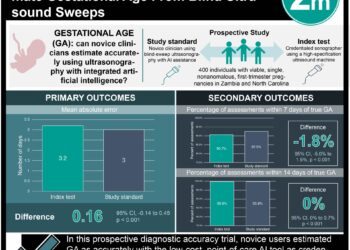Apgar scores provide prognostic information for survival of preterm infants
1. Apgar scores at five and ten minutes after birth provided prognostic information for preterm infants regarding neonatal survival.
2. Lower Apgar scores for older gestational age infants were associated with increased neonatal death compared to younger gestational age infants with similar scores.
Evidence Rating Level: 2 (Good)
Study Rundown: Preterm birth is the leading cause of neonatal death. Current policies from the American Academy of Pediatrics do not recommend using the Apgar score to predict neonatal mortality. Moreover, there no specific recommendations for the use of the scoring system in assessing neonatal mortality of preterm infants. As such, this study investigated the association between risk of neonatal death and Apgar scores. Data from the Swedish Medical Birth Register was utilized to investigate the relationship between the risk of neonatal death and Apgar scores at five minutes, the change between five and ten minutes, and at ten minutes in infants stratified by gestational age. The study concluded the Apgar scores at five and ten minutes after birth were associated with neonatal mortality among preterm infants. This retrospective study was limited by the lack of information regarding interventions during initial stabilization of the infants. These life-saving interventions performed within the first five minutes after birth could have influenced Apgar scores and neonatal survival rates. Furthermore, another limitation to the study was the interobserver variability in the Apgar scores. Nonetheless, this study was strengthened by the large cohort of patients and the homogeneity of the study population.
Click to read the study, published today in NEJM
Relevant Reading: Apgar score and the risk of cause-specific infant mortality: a population-based cohort study
In-Depth [retrospective cohort]: This retrospective study analyzed the records of 113,300 preterm infants born in Sweden. Patients included in this study were infants born between January 1, 1992 and December 31, 2016. Infants were excluded if they had a birth with a gestational completion age greater than 36 week and 6 days. In collaboration with the Swedish Medical Birth Register, this study was granted access to the medical records of the preterm infants. The medical records contained information on prenatal, delivery, and neonatal care. Preterm birth was defined as an infant born with a gestational age between 22 and 36 weeks. The following information was collected: Apgar scores at five and ten minutes after birth, birth characteristics, and information about maternal pregnancy. The gestational age was determined by the ultrasonography-based Swedish reference curve for normal fetal growth. The primary outcome was neonatal death, defined as death within the first 27 completed days of life. Apgar scores at five and ten minutes after birth were available for 98.1% and 92.1% of all preterm birth, respectively. Neonatal mortality increased with decreasing gestational age from 36 weeks (0.2%) to 22 weeks (76.5%). Similarly, neonatal mortality increased with decreasing Apgar scores. Infants born between 22 to 24 weeks with an Apgar score of 0 or 1 had a higher relative risk of neonatal death compared to infants with a score of 9 or 10 (relative risk, 4.7; 95% confidence interval [CI], 2.7 to 8.3). However, the neonatal mortality relative risk substantially increased with older gestational age and lower Apgar scores (relative risk at 35 or 36 weeks, 313.8; 95% CI, 192.5 to 511.4). Taken together, Apgar scores in the context of gestational age provided prognostic information regarding neonatal survival of preterm infants.
Image: PD
©2020 2 Minute Medicine, Inc. All rights reserved. No works may be reproduced without expressed written consent from 2 Minute Medicine, Inc. Inquire about licensing here. No article should be construed as medical advice and is not intended as such by the authors or by 2 Minute Medicine, Inc.







